Detailed Report on Logistics and Supply Chain Management Strategies
VerifiedAdded on 2023/02/01
|10
|2080
|90
Report
AI Summary
This report delves into the intricacies of logistics and supply chain management, examining strategies employed by project leaders, challenges in utilizing information systems like SAP, and the strengths and weaknesses of supply chain transportation systems within an organization. It highlights the importance of effective communication, building high-performance teams, and adapting to project-specific needs. The report also identifies key strategies for optimizing supply chain transportation, such as global thinking and local action, focusing on core strengths, and improving collaboration between manufacturers and suppliers. The analysis provides insights into the inner and outer supply chain components, emphasizing the critical role of supply chain management in enhancing business efficiency.
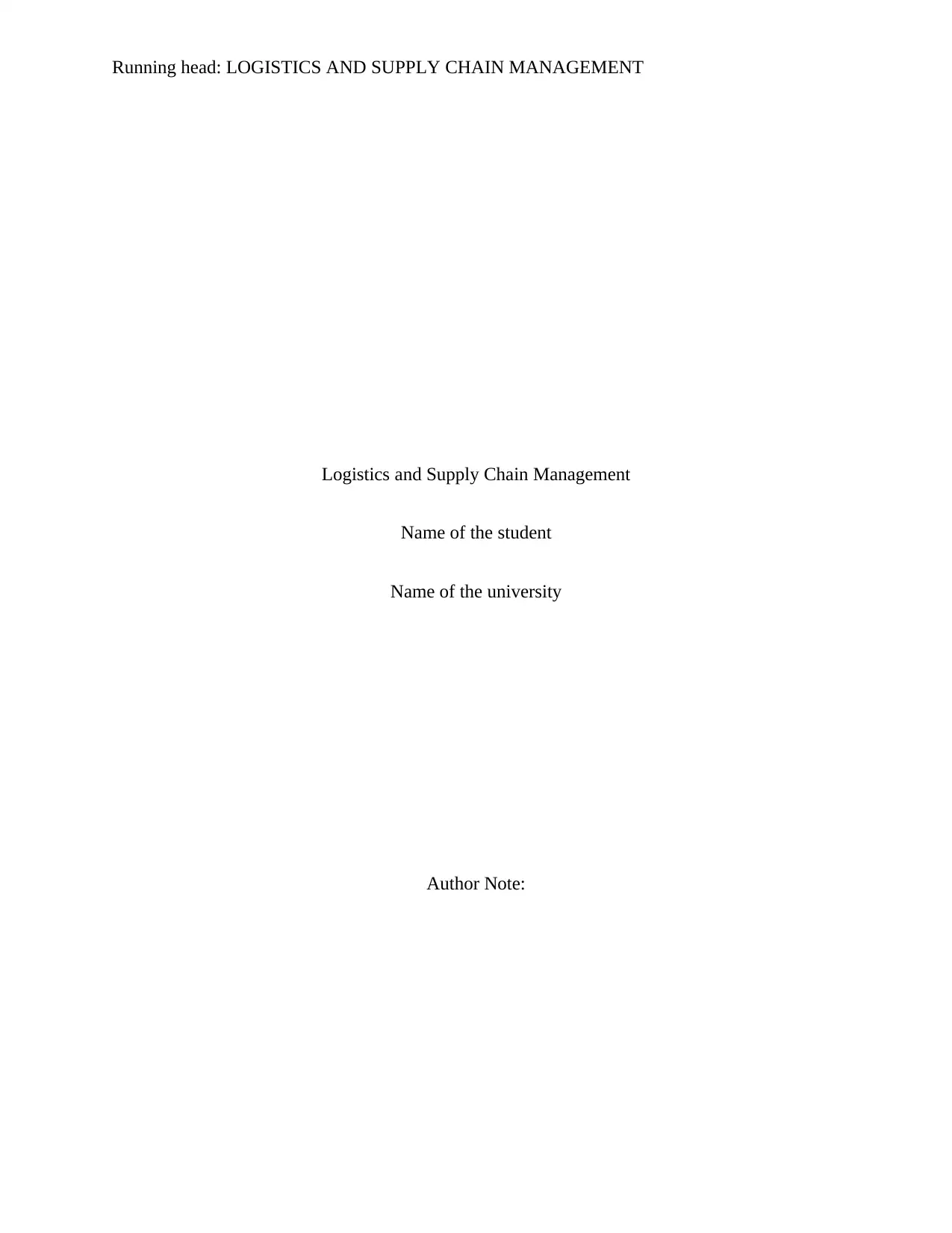
Running head: LOGISTICS AND SUPPLY CHAIN MANAGEMENT
Logistics and Supply Chain Management
Name of the student
Name of the university
Author Note:
Logistics and Supply Chain Management
Name of the student
Name of the university
Author Note:
Paraphrase This Document
Need a fresh take? Get an instant paraphrase of this document with our AI Paraphraser
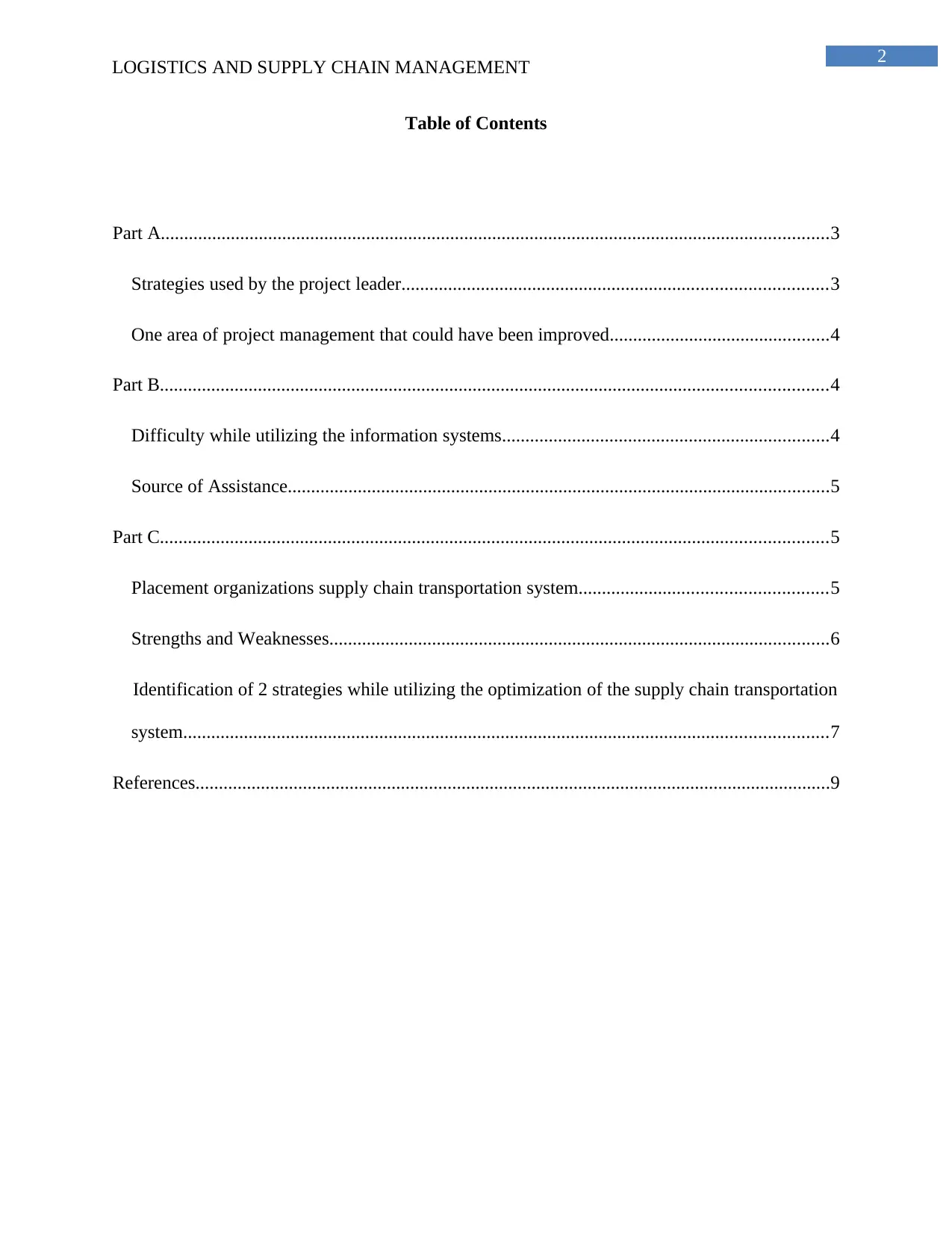
2
LOGISTICS AND SUPPLY CHAIN MANAGEMENT
Table of Contents
Part A...............................................................................................................................................3
Strategies used by the project leader...........................................................................................3
One area of project management that could have been improved...............................................4
Part B...............................................................................................................................................4
Difficulty while utilizing the information systems......................................................................4
Source of Assistance....................................................................................................................5
Part C...............................................................................................................................................5
Placement organizations supply chain transportation system.....................................................5
Strengths and Weaknesses...........................................................................................................6
Identification of 2 strategies while utilizing the optimization of the supply chain transportation
system..........................................................................................................................................7
References........................................................................................................................................9
LOGISTICS AND SUPPLY CHAIN MANAGEMENT
Table of Contents
Part A...............................................................................................................................................3
Strategies used by the project leader...........................................................................................3
One area of project management that could have been improved...............................................4
Part B...............................................................................................................................................4
Difficulty while utilizing the information systems......................................................................4
Source of Assistance....................................................................................................................5
Part C...............................................................................................................................................5
Placement organizations supply chain transportation system.....................................................5
Strengths and Weaknesses...........................................................................................................6
Identification of 2 strategies while utilizing the optimization of the supply chain transportation
system..........................................................................................................................................7
References........................................................................................................................................9
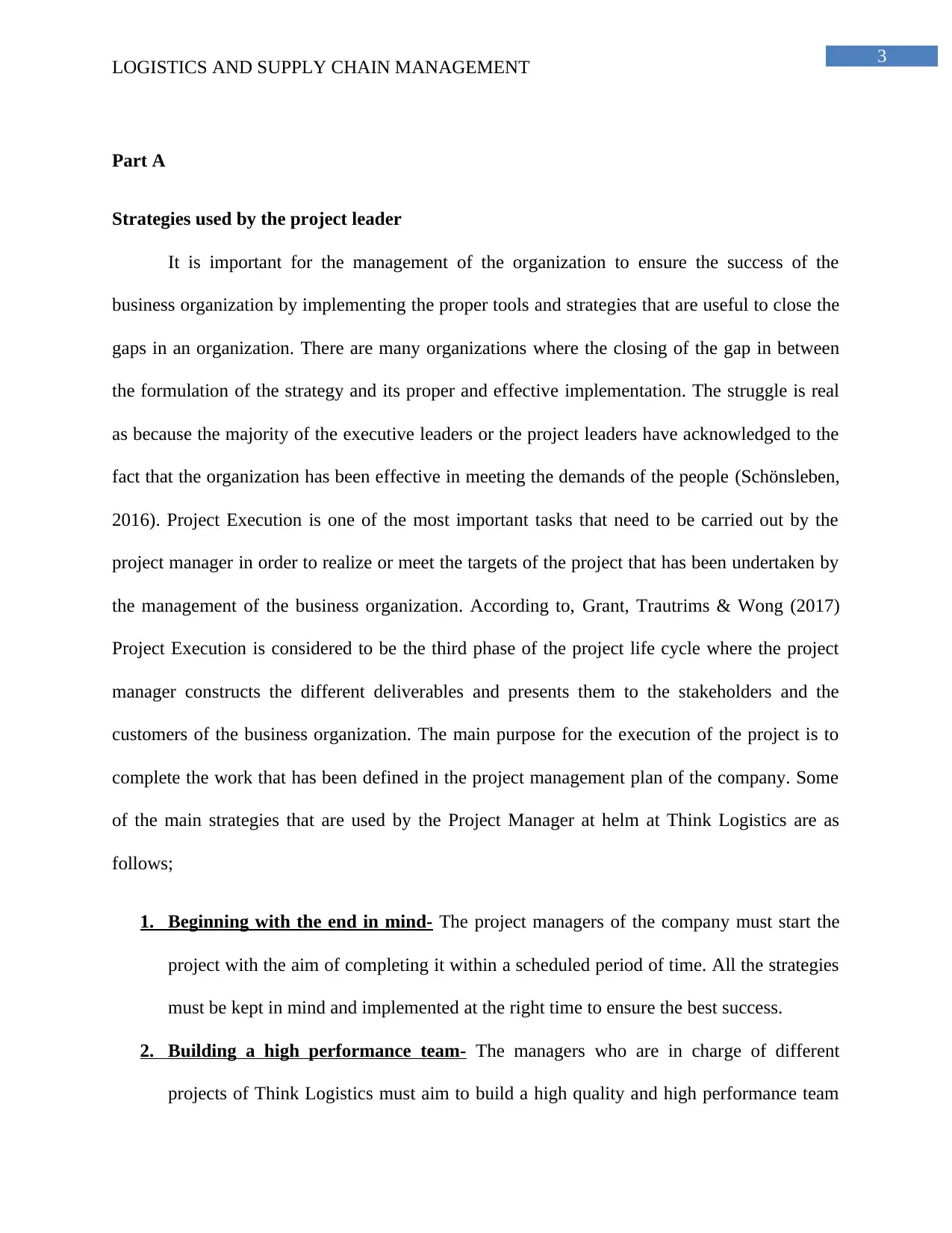
3
LOGISTICS AND SUPPLY CHAIN MANAGEMENT
Part A
Strategies used by the project leader
It is important for the management of the organization to ensure the success of the
business organization by implementing the proper tools and strategies that are useful to close the
gaps in an organization. There are many organizations where the closing of the gap in between
the formulation of the strategy and its proper and effective implementation. The struggle is real
as because the majority of the executive leaders or the project leaders have acknowledged to the
fact that the organization has been effective in meeting the demands of the people (Schönsleben,
2016). Project Execution is one of the most important tasks that need to be carried out by the
project manager in order to realize or meet the targets of the project that has been undertaken by
the management of the business organization. According to, Grant, Trautrims & Wong (2017)
Project Execution is considered to be the third phase of the project life cycle where the project
manager constructs the different deliverables and presents them to the stakeholders and the
customers of the business organization. The main purpose for the execution of the project is to
complete the work that has been defined in the project management plan of the company. Some
of the main strategies that are used by the Project Manager at helm at Think Logistics are as
follows;
1. Beginning with the end in mind- The project managers of the company must start the
project with the aim of completing it within a scheduled period of time. All the strategies
must be kept in mind and implemented at the right time to ensure the best success.
2. Building a high performance team- The managers who are in charge of different
projects of Think Logistics must aim to build a high quality and high performance team
LOGISTICS AND SUPPLY CHAIN MANAGEMENT
Part A
Strategies used by the project leader
It is important for the management of the organization to ensure the success of the
business organization by implementing the proper tools and strategies that are useful to close the
gaps in an organization. There are many organizations where the closing of the gap in between
the formulation of the strategy and its proper and effective implementation. The struggle is real
as because the majority of the executive leaders or the project leaders have acknowledged to the
fact that the organization has been effective in meeting the demands of the people (Schönsleben,
2016). Project Execution is one of the most important tasks that need to be carried out by the
project manager in order to realize or meet the targets of the project that has been undertaken by
the management of the business organization. According to, Grant, Trautrims & Wong (2017)
Project Execution is considered to be the third phase of the project life cycle where the project
manager constructs the different deliverables and presents them to the stakeholders and the
customers of the business organization. The main purpose for the execution of the project is to
complete the work that has been defined in the project management plan of the company. Some
of the main strategies that are used by the Project Manager at helm at Think Logistics are as
follows;
1. Beginning with the end in mind- The project managers of the company must start the
project with the aim of completing it within a scheduled period of time. All the strategies
must be kept in mind and implemented at the right time to ensure the best success.
2. Building a high performance team- The managers who are in charge of different
projects of Think Logistics must aim to build a high quality and high performance team
⊘ This is a preview!⊘
Do you want full access?
Subscribe today to unlock all pages.

Trusted by 1+ million students worldwide
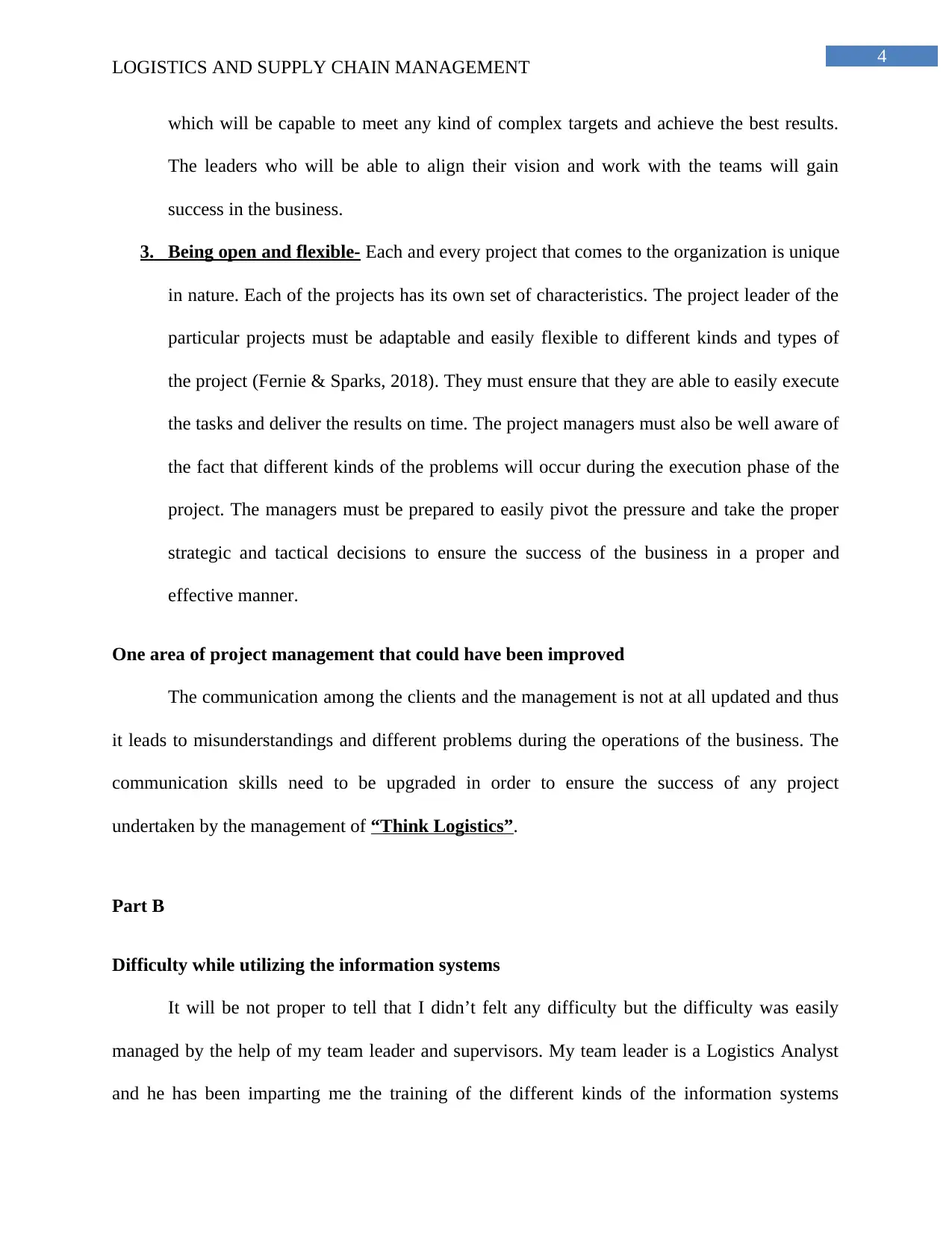
4
LOGISTICS AND SUPPLY CHAIN MANAGEMENT
which will be capable to meet any kind of complex targets and achieve the best results.
The leaders who will be able to align their vision and work with the teams will gain
success in the business.
3. Being open and flexible- Each and every project that comes to the organization is unique
in nature. Each of the projects has its own set of characteristics. The project leader of the
particular projects must be adaptable and easily flexible to different kinds and types of
the project (Fernie & Sparks, 2018). They must ensure that they are able to easily execute
the tasks and deliver the results on time. The project managers must also be well aware of
the fact that different kinds of the problems will occur during the execution phase of the
project. The managers must be prepared to easily pivot the pressure and take the proper
strategic and tactical decisions to ensure the success of the business in a proper and
effective manner.
One area of project management that could have been improved
The communication among the clients and the management is not at all updated and thus
it leads to misunderstandings and different problems during the operations of the business. The
communication skills need to be upgraded in order to ensure the success of any project
undertaken by the management of “Think Logistics”.
Part B
Difficulty while utilizing the information systems
It will be not proper to tell that I didn’t felt any difficulty but the difficulty was easily
managed by the help of my team leader and supervisors. My team leader is a Logistics Analyst
and he has been imparting me the training of the different kinds of the information systems
LOGISTICS AND SUPPLY CHAIN MANAGEMENT
which will be capable to meet any kind of complex targets and achieve the best results.
The leaders who will be able to align their vision and work with the teams will gain
success in the business.
3. Being open and flexible- Each and every project that comes to the organization is unique
in nature. Each of the projects has its own set of characteristics. The project leader of the
particular projects must be adaptable and easily flexible to different kinds and types of
the project (Fernie & Sparks, 2018). They must ensure that they are able to easily execute
the tasks and deliver the results on time. The project managers must also be well aware of
the fact that different kinds of the problems will occur during the execution phase of the
project. The managers must be prepared to easily pivot the pressure and take the proper
strategic and tactical decisions to ensure the success of the business in a proper and
effective manner.
One area of project management that could have been improved
The communication among the clients and the management is not at all updated and thus
it leads to misunderstandings and different problems during the operations of the business. The
communication skills need to be upgraded in order to ensure the success of any project
undertaken by the management of “Think Logistics”.
Part B
Difficulty while utilizing the information systems
It will be not proper to tell that I didn’t felt any difficulty but the difficulty was easily
managed by the help of my team leader and supervisors. My team leader is a Logistics Analyst
and he has been imparting me the training of the different kinds of the information systems
Paraphrase This Document
Need a fresh take? Get an instant paraphrase of this document with our AI Paraphraser
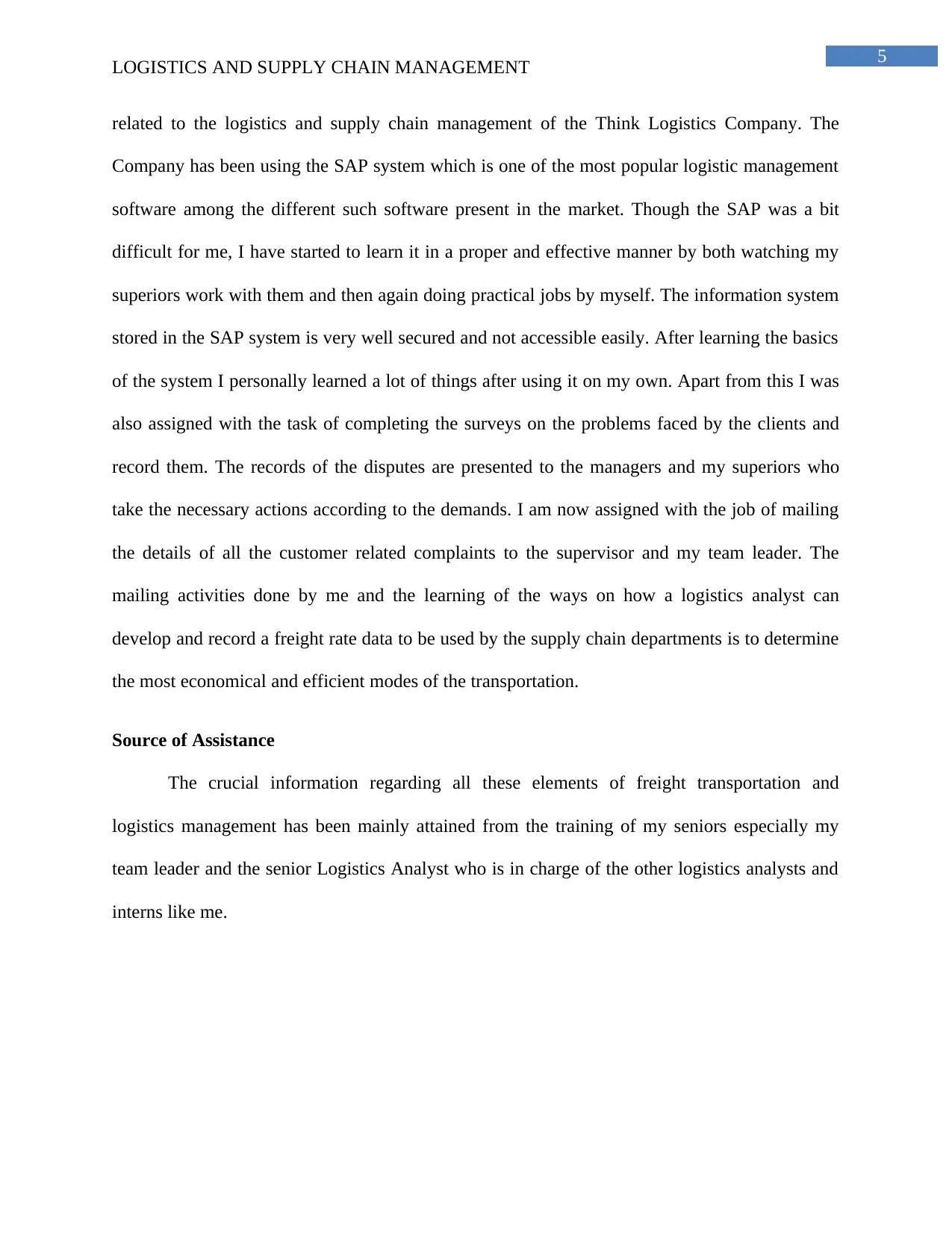
5
LOGISTICS AND SUPPLY CHAIN MANAGEMENT
related to the logistics and supply chain management of the Think Logistics Company. The
Company has been using the SAP system which is one of the most popular logistic management
software among the different such software present in the market. Though the SAP was a bit
difficult for me, I have started to learn it in a proper and effective manner by both watching my
superiors work with them and then again doing practical jobs by myself. The information system
stored in the SAP system is very well secured and not accessible easily. After learning the basics
of the system I personally learned a lot of things after using it on my own. Apart from this I was
also assigned with the task of completing the surveys on the problems faced by the clients and
record them. The records of the disputes are presented to the managers and my superiors who
take the necessary actions according to the demands. I am now assigned with the job of mailing
the details of all the customer related complaints to the supervisor and my team leader. The
mailing activities done by me and the learning of the ways on how a logistics analyst can
develop and record a freight rate data to be used by the supply chain departments is to determine
the most economical and efficient modes of the transportation.
Source of Assistance
The crucial information regarding all these elements of freight transportation and
logistics management has been mainly attained from the training of my seniors especially my
team leader and the senior Logistics Analyst who is in charge of the other logistics analysts and
interns like me.
LOGISTICS AND SUPPLY CHAIN MANAGEMENT
related to the logistics and supply chain management of the Think Logistics Company. The
Company has been using the SAP system which is one of the most popular logistic management
software among the different such software present in the market. Though the SAP was a bit
difficult for me, I have started to learn it in a proper and effective manner by both watching my
superiors work with them and then again doing practical jobs by myself. The information system
stored in the SAP system is very well secured and not accessible easily. After learning the basics
of the system I personally learned a lot of things after using it on my own. Apart from this I was
also assigned with the task of completing the surveys on the problems faced by the clients and
record them. The records of the disputes are presented to the managers and my superiors who
take the necessary actions according to the demands. I am now assigned with the job of mailing
the details of all the customer related complaints to the supervisor and my team leader. The
mailing activities done by me and the learning of the ways on how a logistics analyst can
develop and record a freight rate data to be used by the supply chain departments is to determine
the most economical and efficient modes of the transportation.
Source of Assistance
The crucial information regarding all these elements of freight transportation and
logistics management has been mainly attained from the training of my seniors especially my
team leader and the senior Logistics Analyst who is in charge of the other logistics analysts and
interns like me.
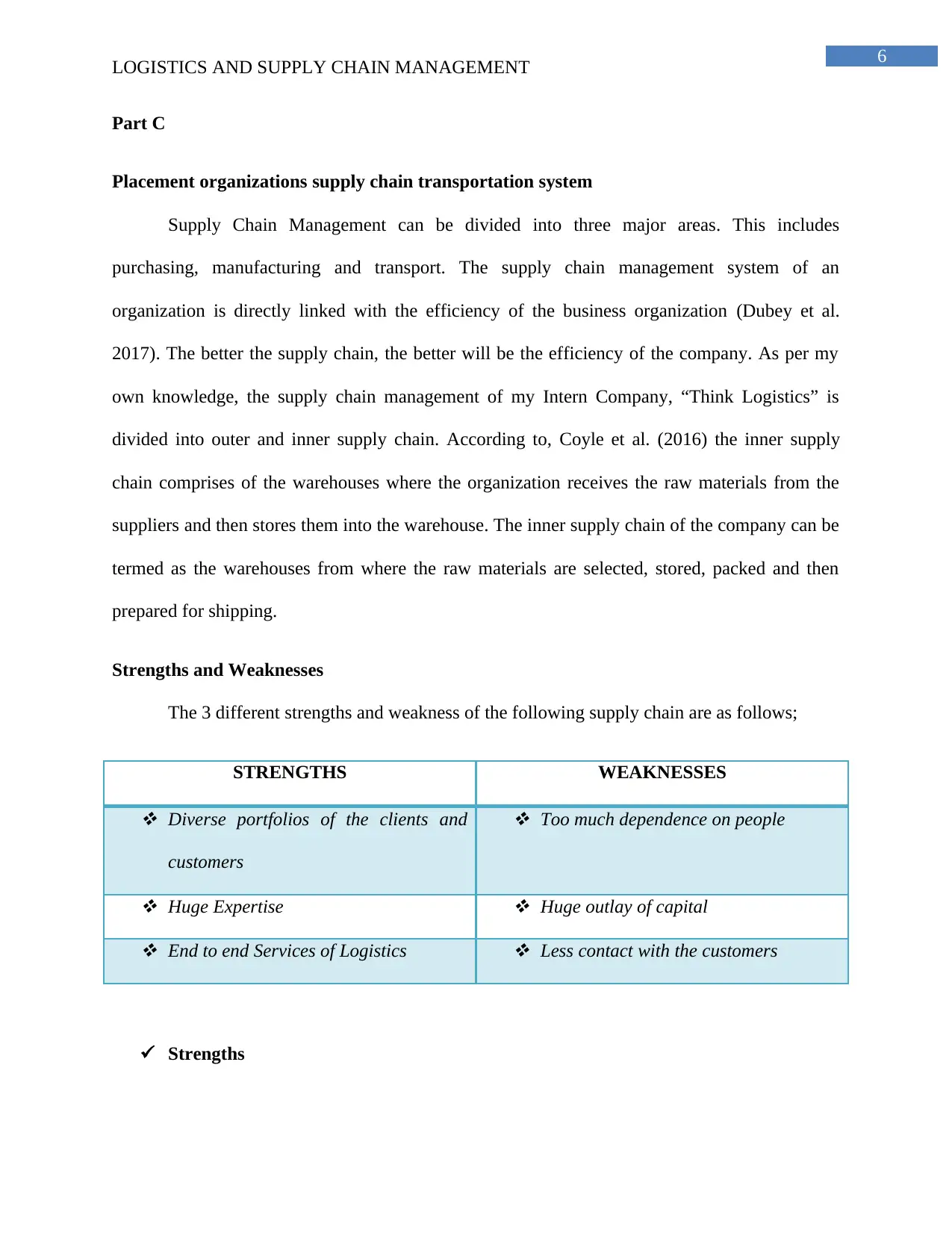
6
LOGISTICS AND SUPPLY CHAIN MANAGEMENT
Part C
Placement organizations supply chain transportation system
Supply Chain Management can be divided into three major areas. This includes
purchasing, manufacturing and transport. The supply chain management system of an
organization is directly linked with the efficiency of the business organization (Dubey et al.
2017). The better the supply chain, the better will be the efficiency of the company. As per my
own knowledge, the supply chain management of my Intern Company, “Think Logistics” is
divided into outer and inner supply chain. According to, Coyle et al. (2016) the inner supply
chain comprises of the warehouses where the organization receives the raw materials from the
suppliers and then stores them into the warehouse. The inner supply chain of the company can be
termed as the warehouses from where the raw materials are selected, stored, packed and then
prepared for shipping.
Strengths and Weaknesses
The 3 different strengths and weakness of the following supply chain are as follows;
STRENGTHS WEAKNESSES Diverse portfolios of the clients and
customers
Too much dependence on people
Huge Expertise
Huge outlay of capital End to end Services of Logistics
Less contact with the customers
Strengths
LOGISTICS AND SUPPLY CHAIN MANAGEMENT
Part C
Placement organizations supply chain transportation system
Supply Chain Management can be divided into three major areas. This includes
purchasing, manufacturing and transport. The supply chain management system of an
organization is directly linked with the efficiency of the business organization (Dubey et al.
2017). The better the supply chain, the better will be the efficiency of the company. As per my
own knowledge, the supply chain management of my Intern Company, “Think Logistics” is
divided into outer and inner supply chain. According to, Coyle et al. (2016) the inner supply
chain comprises of the warehouses where the organization receives the raw materials from the
suppliers and then stores them into the warehouse. The inner supply chain of the company can be
termed as the warehouses from where the raw materials are selected, stored, packed and then
prepared for shipping.
Strengths and Weaknesses
The 3 different strengths and weakness of the following supply chain are as follows;
STRENGTHS WEAKNESSES Diverse portfolios of the clients and
customers
Too much dependence on people
Huge Expertise
Huge outlay of capital End to end Services of Logistics
Less contact with the customers
Strengths
⊘ This is a preview!⊘
Do you want full access?
Subscribe today to unlock all pages.

Trusted by 1+ million students worldwide
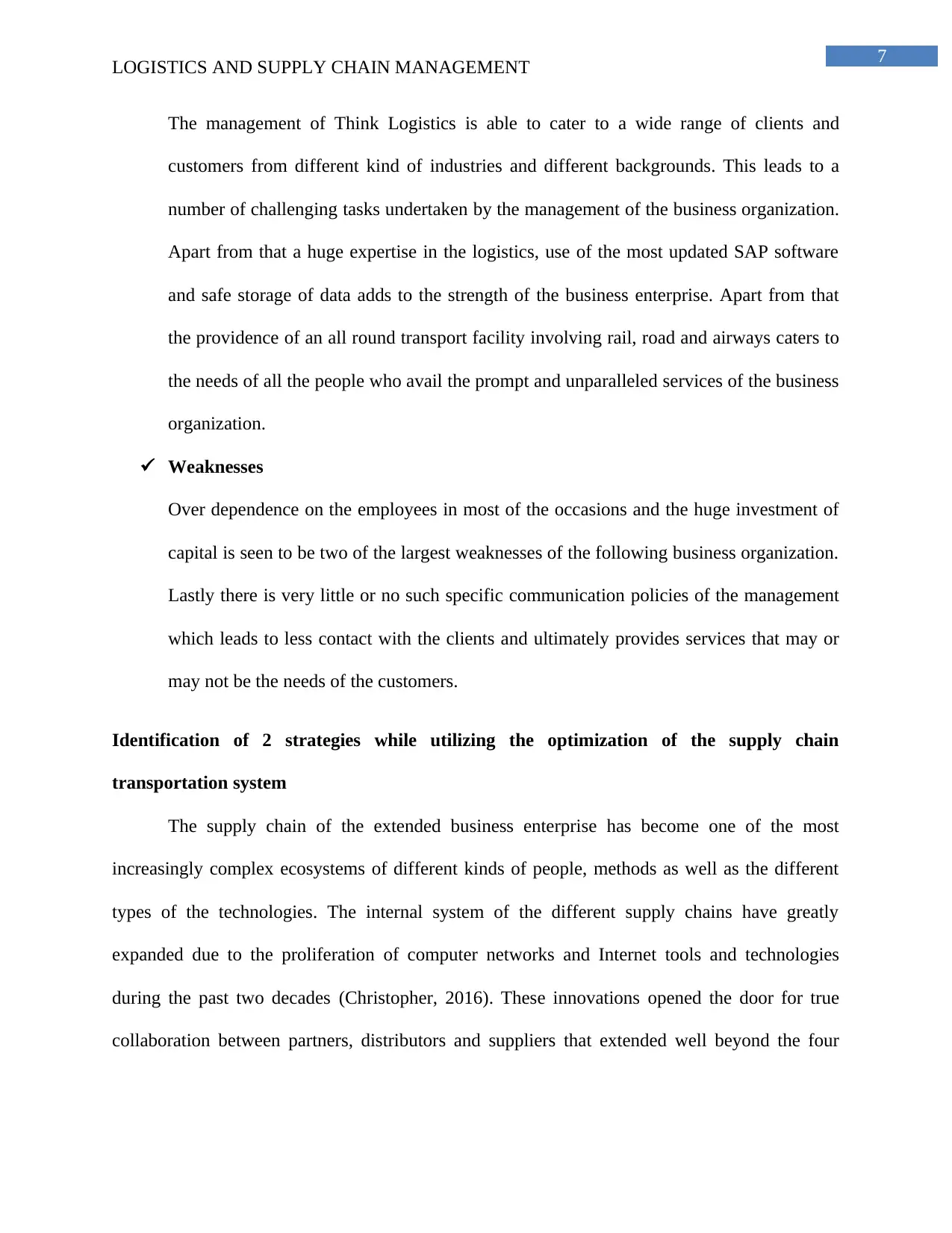
7
LOGISTICS AND SUPPLY CHAIN MANAGEMENT
The management of Think Logistics is able to cater to a wide range of clients and
customers from different kind of industries and different backgrounds. This leads to a
number of challenging tasks undertaken by the management of the business organization.
Apart from that a huge expertise in the logistics, use of the most updated SAP software
and safe storage of data adds to the strength of the business enterprise. Apart from that
the providence of an all round transport facility involving rail, road and airways caters to
the needs of all the people who avail the prompt and unparalleled services of the business
organization.
Weaknesses
Over dependence on the employees in most of the occasions and the huge investment of
capital is seen to be two of the largest weaknesses of the following business organization.
Lastly there is very little or no such specific communication policies of the management
which leads to less contact with the clients and ultimately provides services that may or
may not be the needs of the customers.
Identification of 2 strategies while utilizing the optimization of the supply chain
transportation system
The supply chain of the extended business enterprise has become one of the most
increasingly complex ecosystems of different kinds of people, methods as well as the different
types of the technologies. The internal system of the different supply chains have greatly
expanded due to the proliferation of computer networks and Internet tools and technologies
during the past two decades (Christopher, 2016). These innovations opened the door for true
collaboration between partners, distributors and suppliers that extended well beyond the four
LOGISTICS AND SUPPLY CHAIN MANAGEMENT
The management of Think Logistics is able to cater to a wide range of clients and
customers from different kind of industries and different backgrounds. This leads to a
number of challenging tasks undertaken by the management of the business organization.
Apart from that a huge expertise in the logistics, use of the most updated SAP software
and safe storage of data adds to the strength of the business enterprise. Apart from that
the providence of an all round transport facility involving rail, road and airways caters to
the needs of all the people who avail the prompt and unparalleled services of the business
organization.
Weaknesses
Over dependence on the employees in most of the occasions and the huge investment of
capital is seen to be two of the largest weaknesses of the following business organization.
Lastly there is very little or no such specific communication policies of the management
which leads to less contact with the clients and ultimately provides services that may or
may not be the needs of the customers.
Identification of 2 strategies while utilizing the optimization of the supply chain
transportation system
The supply chain of the extended business enterprise has become one of the most
increasingly complex ecosystems of different kinds of people, methods as well as the different
types of the technologies. The internal system of the different supply chains have greatly
expanded due to the proliferation of computer networks and Internet tools and technologies
during the past two decades (Christopher, 2016). These innovations opened the door for true
collaboration between partners, distributors and suppliers that extended well beyond the four
Paraphrase This Document
Need a fresh take? Get an instant paraphrase of this document with our AI Paraphraser
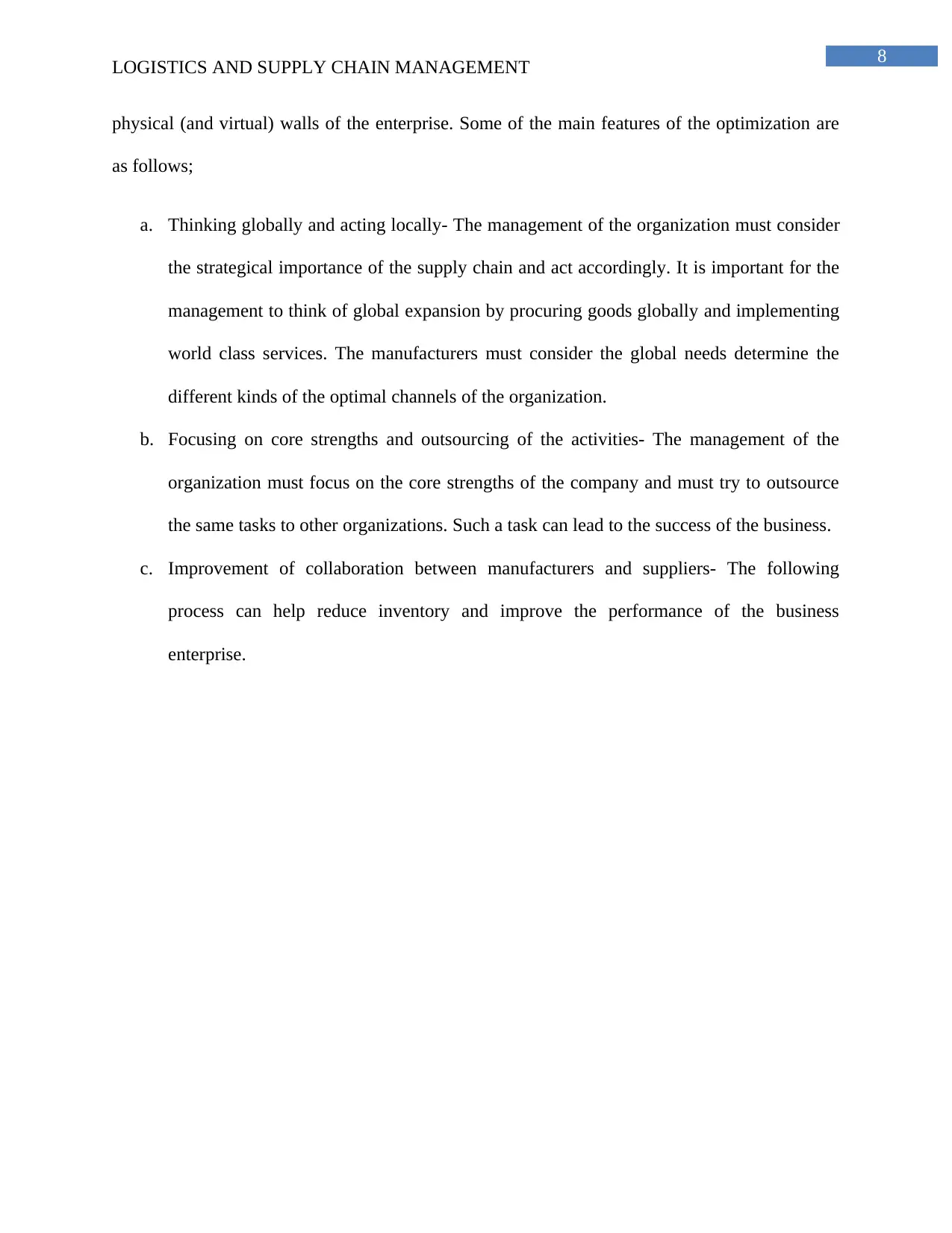
8
LOGISTICS AND SUPPLY CHAIN MANAGEMENT
physical (and virtual) walls of the enterprise. Some of the main features of the optimization are
as follows;
a. Thinking globally and acting locally- The management of the organization must consider
the strategical importance of the supply chain and act accordingly. It is important for the
management to think of global expansion by procuring goods globally and implementing
world class services. The manufacturers must consider the global needs determine the
different kinds of the optimal channels of the organization.
b. Focusing on core strengths and outsourcing of the activities- The management of the
organization must focus on the core strengths of the company and must try to outsource
the same tasks to other organizations. Such a task can lead to the success of the business.
c. Improvement of collaboration between manufacturers and suppliers- The following
process can help reduce inventory and improve the performance of the business
enterprise.
LOGISTICS AND SUPPLY CHAIN MANAGEMENT
physical (and virtual) walls of the enterprise. Some of the main features of the optimization are
as follows;
a. Thinking globally and acting locally- The management of the organization must consider
the strategical importance of the supply chain and act accordingly. It is important for the
management to think of global expansion by procuring goods globally and implementing
world class services. The manufacturers must consider the global needs determine the
different kinds of the optimal channels of the organization.
b. Focusing on core strengths and outsourcing of the activities- The management of the
organization must focus on the core strengths of the company and must try to outsource
the same tasks to other organizations. Such a task can lead to the success of the business.
c. Improvement of collaboration between manufacturers and suppliers- The following
process can help reduce inventory and improve the performance of the business
enterprise.
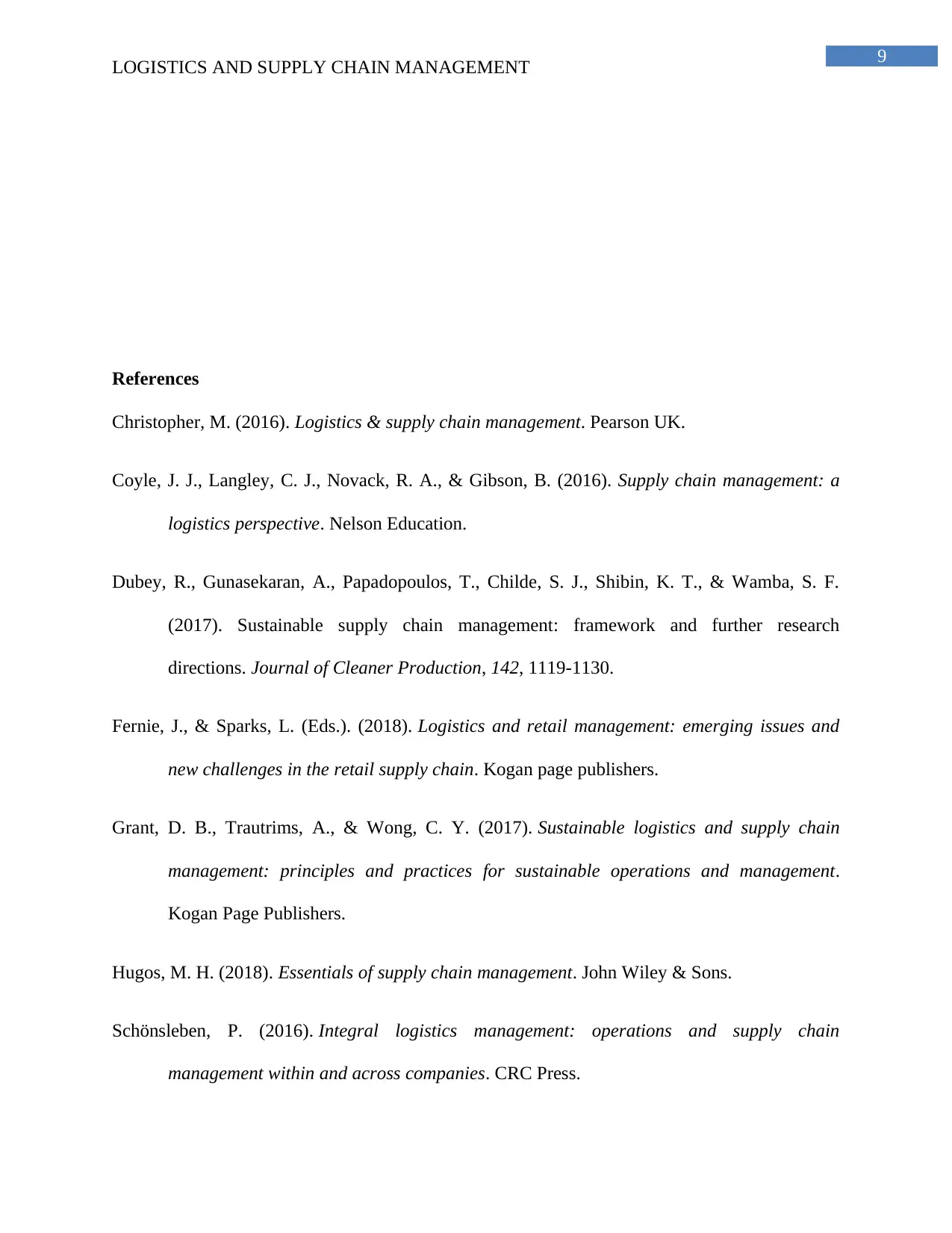
9
LOGISTICS AND SUPPLY CHAIN MANAGEMENT
References
Christopher, M. (2016). Logistics & supply chain management. Pearson UK.
Coyle, J. J., Langley, C. J., Novack, R. A., & Gibson, B. (2016). Supply chain management: a
logistics perspective. Nelson Education.
Dubey, R., Gunasekaran, A., Papadopoulos, T., Childe, S. J., Shibin, K. T., & Wamba, S. F.
(2017). Sustainable supply chain management: framework and further research
directions. Journal of Cleaner Production, 142, 1119-1130.
Fernie, J., & Sparks, L. (Eds.). (2018). Logistics and retail management: emerging issues and
new challenges in the retail supply chain. Kogan page publishers.
Grant, D. B., Trautrims, A., & Wong, C. Y. (2017). Sustainable logistics and supply chain
management: principles and practices for sustainable operations and management.
Kogan Page Publishers.
Hugos, M. H. (2018). Essentials of supply chain management. John Wiley & Sons.
Schönsleben, P. (2016). Integral logistics management: operations and supply chain
management within and across companies. CRC Press.
LOGISTICS AND SUPPLY CHAIN MANAGEMENT
References
Christopher, M. (2016). Logistics & supply chain management. Pearson UK.
Coyle, J. J., Langley, C. J., Novack, R. A., & Gibson, B. (2016). Supply chain management: a
logistics perspective. Nelson Education.
Dubey, R., Gunasekaran, A., Papadopoulos, T., Childe, S. J., Shibin, K. T., & Wamba, S. F.
(2017). Sustainable supply chain management: framework and further research
directions. Journal of Cleaner Production, 142, 1119-1130.
Fernie, J., & Sparks, L. (Eds.). (2018). Logistics and retail management: emerging issues and
new challenges in the retail supply chain. Kogan page publishers.
Grant, D. B., Trautrims, A., & Wong, C. Y. (2017). Sustainable logistics and supply chain
management: principles and practices for sustainable operations and management.
Kogan Page Publishers.
Hugos, M. H. (2018). Essentials of supply chain management. John Wiley & Sons.
Schönsleben, P. (2016). Integral logistics management: operations and supply chain
management within and across companies. CRC Press.
⊘ This is a preview!⊘
Do you want full access?
Subscribe today to unlock all pages.

Trusted by 1+ million students worldwide
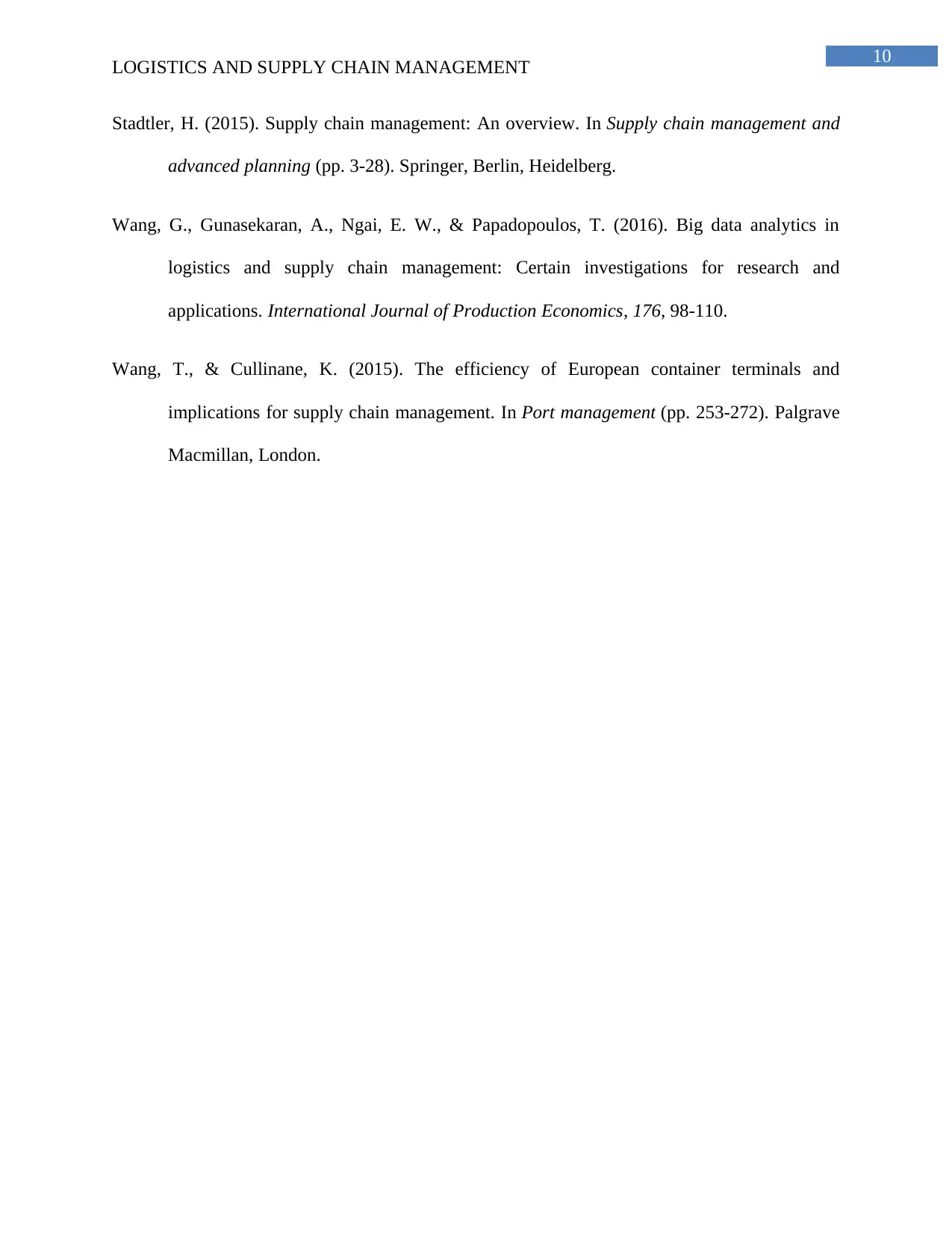
10
LOGISTICS AND SUPPLY CHAIN MANAGEMENT
Stadtler, H. (2015). Supply chain management: An overview. In Supply chain management and
advanced planning (pp. 3-28). Springer, Berlin, Heidelberg.
Wang, G., Gunasekaran, A., Ngai, E. W., & Papadopoulos, T. (2016). Big data analytics in
logistics and supply chain management: Certain investigations for research and
applications. International Journal of Production Economics, 176, 98-110.
Wang, T., & Cullinane, K. (2015). The efficiency of European container terminals and
implications for supply chain management. In Port management (pp. 253-272). Palgrave
Macmillan, London.
LOGISTICS AND SUPPLY CHAIN MANAGEMENT
Stadtler, H. (2015). Supply chain management: An overview. In Supply chain management and
advanced planning (pp. 3-28). Springer, Berlin, Heidelberg.
Wang, G., Gunasekaran, A., Ngai, E. W., & Papadopoulos, T. (2016). Big data analytics in
logistics and supply chain management: Certain investigations for research and
applications. International Journal of Production Economics, 176, 98-110.
Wang, T., & Cullinane, K. (2015). The efficiency of European container terminals and
implications for supply chain management. In Port management (pp. 253-272). Palgrave
Macmillan, London.
1 out of 10
Related Documents
Your All-in-One AI-Powered Toolkit for Academic Success.
+13062052269
info@desklib.com
Available 24*7 on WhatsApp / Email
![[object Object]](/_next/static/media/star-bottom.7253800d.svg)
Unlock your academic potential
Copyright © 2020–2025 A2Z Services. All Rights Reserved. Developed and managed by ZUCOL.





